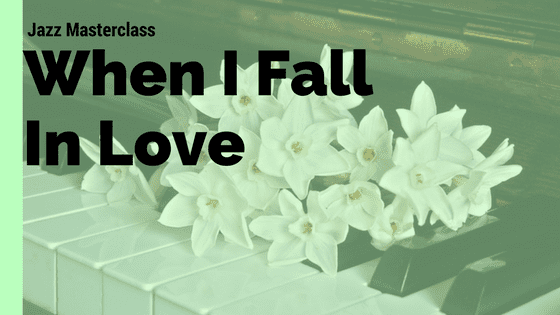Jazz Masterclass - "When I Fall In Love"

This jazz masterclass article will present a few different ways to go about playing a jazz standard like a pro in a quick, straightforward manner. We will discuss some basic concepts (and an advanced concept or two) that can help you tweak your playing using the first 2 measures of the beautiful jazz ballad "When I Fall In Love" in all of our examples.
Jazz Masterclass: The Bare Minimum
Before you can really dig deep into the advanced jazz harmony concepts you first have to do some bare minimum prep work. This requires that you listen repeatedly to various versions (meaning more than 1) of the tune. Try to memorize things like tempo, meter, form, and the melody (and even the chords!) before you begin to play. To help get you started check out Nat King Cole's version as well as Bill Evans'.
Jazz Masterclass: Chord Shells
An easy way to get a jazz tune up on its legs quickly is to simply play the melody in the right hand and the chord shells in the left hand. Chord shells refer to the root of the chord and at least one of the other chord tones (and sometimes two). The chord tones refer to the root, 3rd, 5, and 7th of a chord. So by completing this step you're getting the basic harmony played for each chord.
(NOTE: If you're having trouble reaching the interval of the 10th in the left hand, simply play the root with your left hand and the higher note with your right hand).
Jazz Masterclass: Filling in the Harmony
Chord shells are a basic first step. But from there we can start to flesh out the rest of the harmony by adding more notes to the chords and the melody. We're not adding any additional chords or substitutions (yet). Just staying with the original harmony but beefing things up a bit.
Jazz Masterclass: Basic Stride Approach
A simple way to think about stride piano is to play the root of the chord on beat 1 and the chord itself on beat 2. Then play the root of the new chord on beat 3 and the chord itself on beat 4.
Jazz Masterclass: Advanced Reharm
Now for some juicy stuff. We're going to start on Eb for our first chord and end at the Bb7 chord in measure 2. But we're going to use chromatically descending chords to get there. What will that look like? Well, like this:
How did we do that? Starting with D7 every chord acts as a V7 leading to the next chord, except that instead of "V7 to I" we're using the tritone substitutions of those V7 chords. You see, what's really happening is this:
All that we really did is use a tritone substitution in place of the G7 chord (Db7) and F7 chord (B7) in order to create the chromatic descent (i.e., half-step motion) in the roots of the chords. That allows us to come up with some lush harmonies like this:





